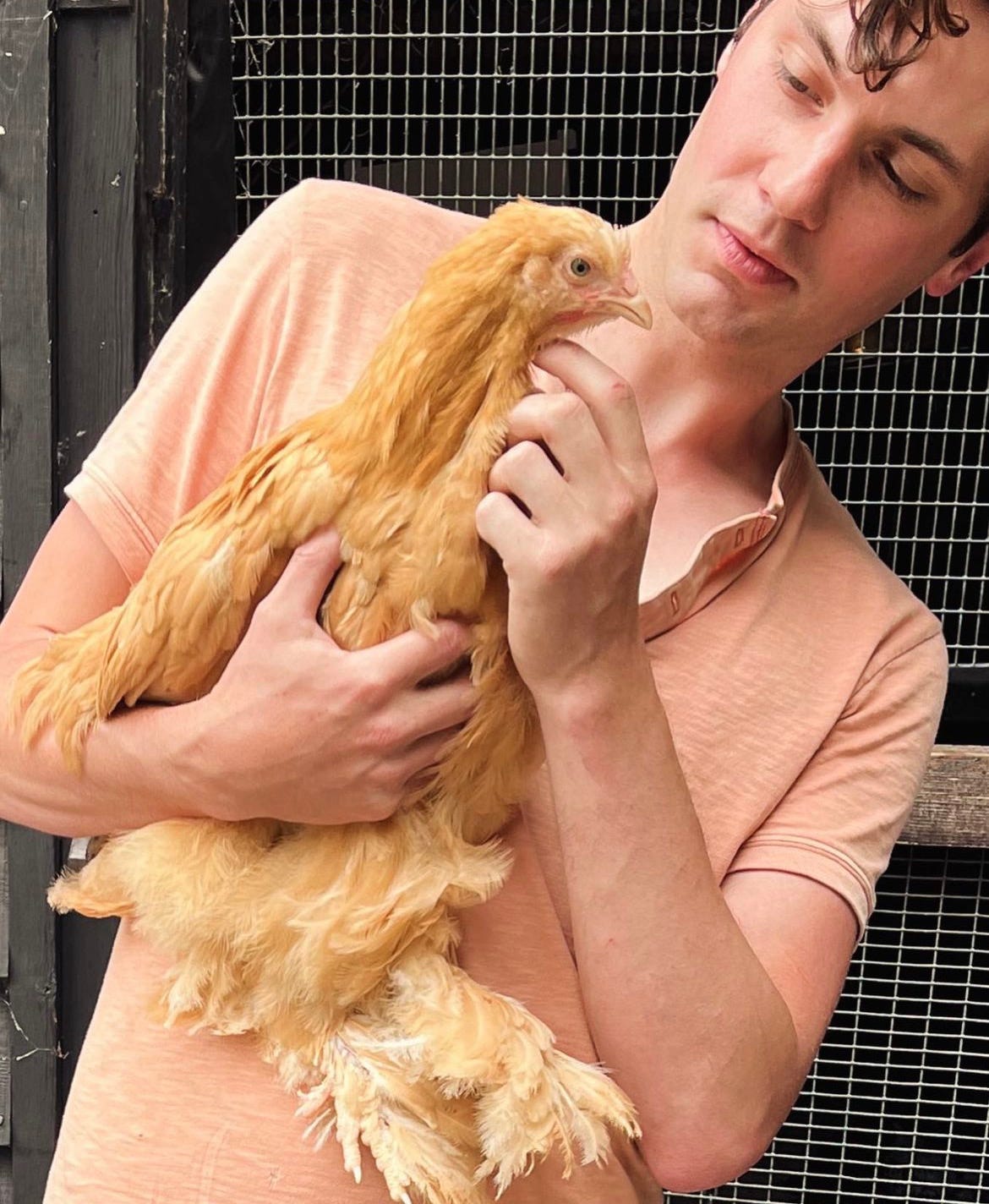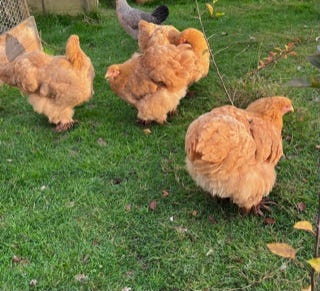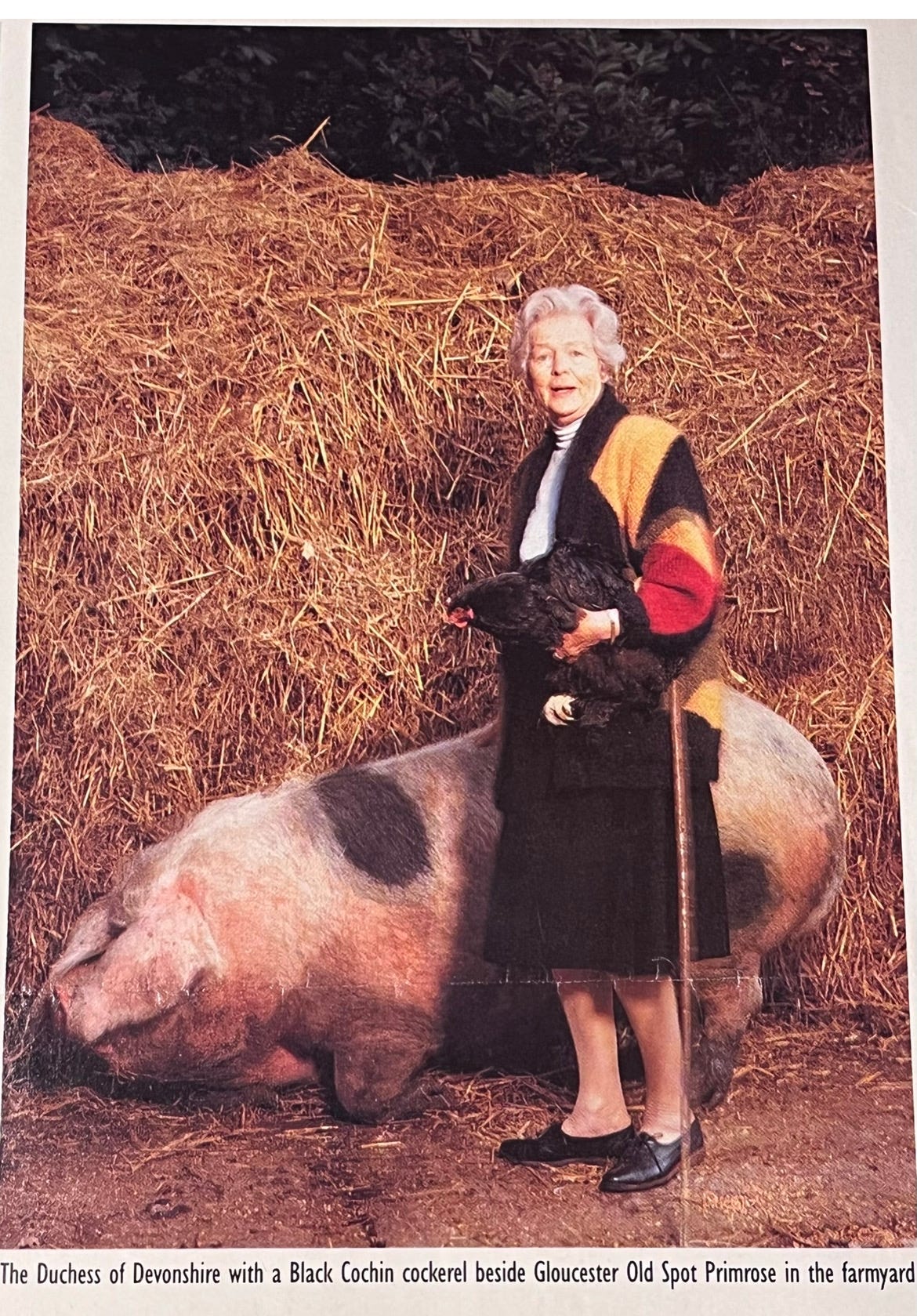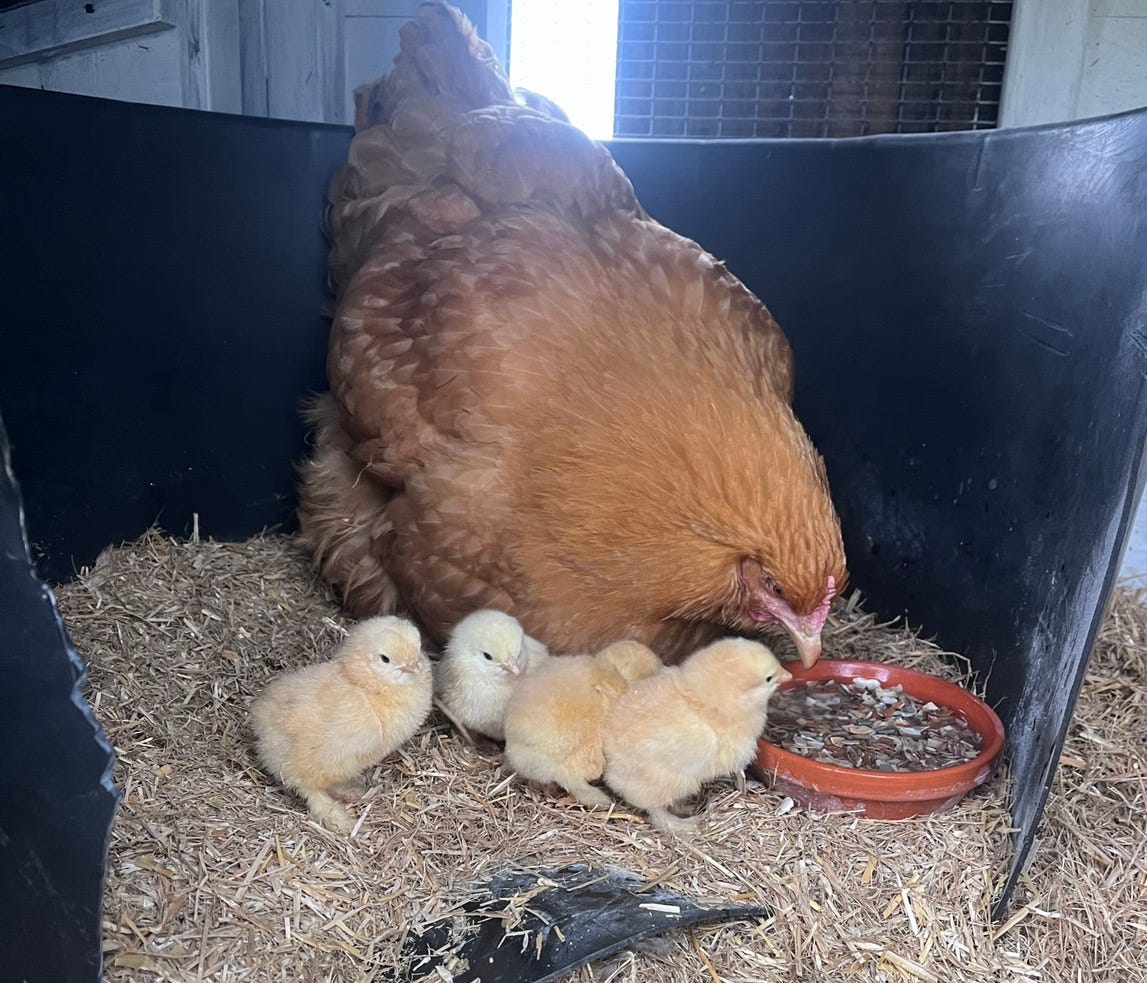My drawings of Buff Cochins - hen and cock.
Great champagne, ginger biscuits looking from a distance like moving plumped up pillows. Buff Cochins chickens I remember from childhood visits to Chatsworth in Derbyshire where they seemed so huge yet cuddly, plodding about the gardens lawns with ease and confidence, seeking crumbs from those who had picnics. Longleat has always had its lions and Chatsworth I hope will always have its Cochins. Today I am working with the farmyard at Chatsworth, namely dearest Samantha who looks after the farmyards hens there and the Cochin club to help ensure their survival.
Holding a young Buff Cochin hen, who hatched via an egg here sent in the post by me!
My young cochin hens hatched this year.
Their heyday at Chatsworth was back in the 80’s and 90’s when Deborah Devonshire famously as Duchess really indulged in her passion for poultry and kept a great many breeds. The cochins were the only fowl that were granted a privileged license of being at liberty. This was because they do not cause much disturbance to the flower beds due to their feathered legs. They would peck around the potting sheds and would preen around their lovely traditional shed of a hen house that sat opposite the marzipan plantings of the cottage garden.
As a chicken crazed child, the place was truly full of hens so it was like Disney land really for me, especially so because these hens in particular were free ranging.
In her book , The Garden at Chatsworth published in 1999, a work that outranks many modern gardening books done about stately home gardens today, Deborah Devonshire notes that her Cochins must be ‘the most photographed of poultry in the land’.
Like a lot of pure and old poultry breeds though today, Buff Cochins are now in just a few hands.
The flock of them at Chatsworth almost died out completely due to a badger killing a number of birds and with them simply not being the easiest of chickens to manage.
When Deborah was Duchess, she employed Mr Alan Shimwell to oversee her hens which was quite a task given the numbers kept. The beautiful hexagonal Game Larder that nestles in its own little hollow in the car park housed some 200 laying hens of hybrid Rhode Island Red layers, along with Duchess Deborah’s beloved terracotta egg laying Welsummers and Snow White yellow legged leghorns that scatter gunned across the car park in hen parties greeting visitors and pecking around the parked cars. They laid eggs that supplied the farm shop. It was Alan who oversaw the two Cochin hens and a Cochin cockerel famously installed one evening atop a states room dining table as living table arrangements for the visiting fashion designer Oscar de la Renta!
In the autumn at Chatsworth, a famous poultry sale would take place in the farmyard and adventure early in the morning that saw people queue up with various hampers and cat baskets at dawn, eager to purchase the Duchess’s young hens of the season. The Cochin pullets were always in short supply and quickly sold.
Thanks to the Cochin clubs secretary Emma Armstead, a precious trio of Buff Cochins was returned to the farmyard a few years ago now. Emma had managed to rear the last Buff Cochins from the late and esteemed poultryman Peter Heywood. Peter gave many Cochins to Chatsworth over the years from his champion stock and so Chatsworth Cochins became well known on the poultry show-scene.
Peter Heywood at Chatsworth.
They are very docile as chicken personalities go. This I find refreshing because hens can be so wicked to one another. Cochins rarely seem to adopt the typical pecking order streak of being bully birds. As chubby fluff balls of week old yellow chicks, once they grow their first set of proper little tangerine coloured trouser feathered pyjamas, they resemble chicken infant equivalents of golden retriever puppies. Completely adorable.
posting eggs out to chatsworth - carefully wrapped!
As adults, the hens suffer quickly from too much attention from their cockerel who’s passions result in them looking very plucked and ravaged. They need to be kept out of the mud too, checked for mites and they are bullied often by more robust breeds. They are also greedy birds if they can’t free range far and wide then they must not be fed too much corn so they don’t become fat. Fat hens aren’t healthy ones and heart attacks and problems when it comes to laying are the result.
As young birds, they are slow to mature, taking a year of growing before their aptly titled cushions (the rounded, bouffanted like tail feathers) fully blossom. Add to this the fact that they aren’t the best of layers, Cochins are a required and dedicated taste. They are also due to their similar colour often mistaken for the more popular Buff Orpingtons, that don’t have feathered legs. They are however the most wonderful sight to behold and are friendly and jolly birds to own. I like the challenge they provide after rearing hens now for several years and the feeling that Debo would be delighted of us trying to keep their presence going at Chatsworth is very special for me.
Deborah Devonshire with a number of her hens at Chatsworth.
It’s been a fairly successful first year of rearing and breeding my own Buff Cochins. For my birthday last year, I returned to my now strangely resident -ish postcode of GL7 in the dark of a taxi with a box of young Cochins, a cock and two hens known as a trio. These made the foundation of my breeding stock.
I’m renting some land on a nearby farm that I have fenced like Jurassic park, necessarily against foxes and within it I have a chicken run animation worthy assembly of hen houses. These have made by the wonderful Domestic fowl trust and several of them stand on stilts. This is where any small amount of spare book money goes I’ll probably end up living in one in the years to come because there is little chance of me ever getting a mortgage.
As the It’s much better to them them cosy and bedded down with lots of chopped straw so the grass can rest and not be churned up. I have spent a stomach turning amount also on mud matts for this reason.
Many Cochin eggs have been hatched this year, both here and also back at the farmyard at Chatsworth because any spare eggs I have been taking for the team there to hatch. They have a big incubator and eggs are set to be hatched here about every 9 days or so over the spring and early summer months. The resulting broods are reared in a block of stables and it is lovely to see the different ages of chicks as the season progresses.
Much has been learnt and a lot of good things confirmed. Firstly that chickens of any breed are much smarter and I think surely happier if they are reared by an actual hen rather than artificially. This traditional way is not always practical nor efficient but I’ve never really loved incubators some people get very hooked on them though and they are helpful for hatching large numbers of eggs. For me however I think they take away a huge part of what is natural, time forgotten poultry husbandry and having motherless broods of chicks that require quite a lot of tending to in comparison to letting a hen get on with all the work with great common sense and instinct, isn’t something that I find much fun. Chicks with a good hen to oversee them can be allowed out onto short grass to peck at and they figure out the outside world and it’s ways quickly which is a help for them as adult birds.
This picture book image of Mother Nature at her best, hasn’t all been bliss though. My first broody hen of this year was indeed a Cochin.
She proved to be a good sitter and none of her eggs were broken during incubation but her uneasy footwork ( claws of big feathered feet) proved fatal once the chicks hatched. Chicks understandably being newborns, are quite floppy and tiered in their first 48 hours of life and of half the clutch of chicks that hatched, the cochin hen accidentally stood on.
The lesson for next year is that if a Cochin hen is allowed to hatch her eggs herself is that the chicks will be kept in an incubator for the first 2 days after hatching so that they are stronger and more able to move out of the way of their mother cochins feet.
The best success of natural rearing was thanks to a broody old cream legbar hen going surprisingly broody. She proved to be a very aggressive sitter to my hands on egg inspections griping my skin with her beak and drawing blood even on occasion but she reared her chicks such great dedication and delight it was all worthwhile.
At the time of writing, I now have 6 young Buff Cochin hens for next year along with the two original hens plus 3 young cockerels. The latter are being kept in a bachelor group. They’ll be allowed to rang with the hens next May for a few weeks to ensure fertile eggs but the hens will probably have to be fitted with back protecting fabric saddles! It’s important the hens aren’t given too much corn either over the winter just a few handfuls on cold evenings to help them stay warm as they roost as fat hens don’t lay well! I am looking forward to taking their fertile eggs to be hatched at Chatsworth next year and it’s a wonderful sight to watch them today, looking like feathered plumptious pumpkins in the autumn sunshine.
Cochins in the farmyard at Chatsworth, rich tangerine jam gentle giants amongst chickens.

















what a relief to read this and look at these ultra fabu fluff-beings!....here is the states we are infected with an ongoing/unbearable torrent of political slime as the empire descends into broken madness.....I've read with great glee your garden books/ty very much....keep writing we need you! ...btw did you ever read: Dear Friend and gardener; letters on life and gardening by Christopher Lloyd and Beth Chatto? just finished it/loved it......also recommend: Grounded in the Garden by TJ Maher...
I am currently on holiday in the Peaks and will be visiting Chatsworth which I greatly looking forward to. I used to have a wonderful Brahma called Orlando who was tricky to look after but so sweet natured. I love reading of your hens, they are such joyful creatures.